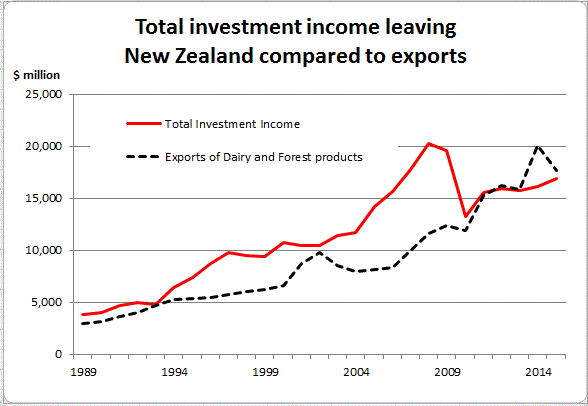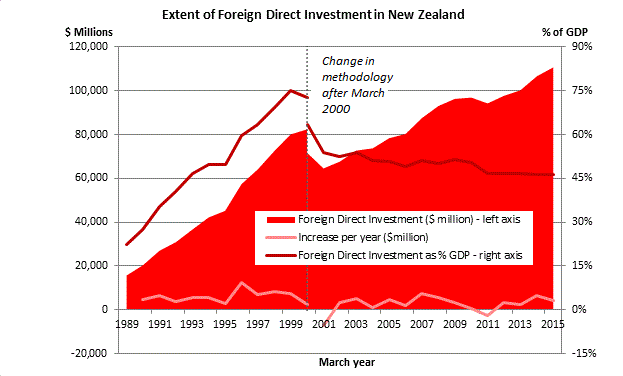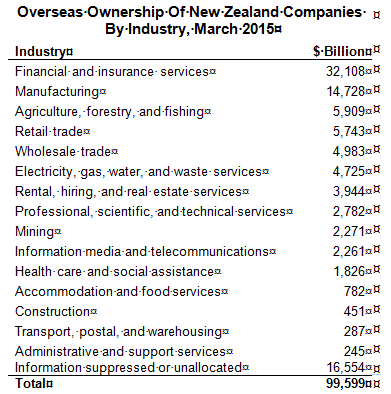Overseas Investment In New Zealand
How Much, How Good?
- Bill Rosenberg
Reproduced with permission, from the NZ Council of Trade Unions’ CTU Monthly Economic Bulletin 172, September 2015. When asked if this is any different to his speech to CAFCA’s 40th anniversary celebration event (published in Watchdog 139, August 2015, “Foreign Investment And The Economy”, http://www.converge.org.nz/watchdog/39/02.html), Bill replied: “A lot of common stuff, but some new regarding the new Government push for more overseas investment and figures updated to 2015”. Ed.
Summary
Overseas investment is frequently controversial. When transnational corporations misbehave or try to influence governments (including in treaties like the Trans Pacific Partnership Agreement [TPPA]) they attract odium. Land sales to overseas buyers are controversial for understandable reasons. But ongoing business investment frequently flies under the radar and is economically much more important.
The Government recently announced an initiative to attract more overseas investment. In doing so it admitted that the usually claimed benefits had largely not eventuated in New Zealand. It wants to attract higher quality investment but because most of our ability to be elective and attach conditions to business investment has been signed away in trade and investment agreements, it can only do so by spending a lot of time wooing selected investors and making life as easy for them as possible.
The new investment it estimates is needed is $160-200 billion. If all that came from overseas investment, it would cost New Zealand around $13-16 billion a year in profits going overseas to the investors. This would roughly double the investment income going overseas, which already accounts for virtually all of the current account deficit. It is about equal to the value of dairy and forestry exports. We have good reason to ask whether this is value for money.
Evidence compiled by researchers on the quality of existing overseas companies (‘foreign direct investment’) is that it is low quality. It targets high performing local firms but does not generally raise productivity; there is little evidence local suppliers and customers benefit by learning from overseas firms’ practices; there is little wage premium (about 3%) nor sign that their workers pick up skills that are useful when they move to another employer. There are many examples of debt-loaded leveraged buyouts, asset stripping and tax avoidance.
Overseas firms employ about one in six employees, but account for around a quarter of business assets so are not strong job creators. Concentrated in low competition areas of the economy (like finance), they export less and make much higher rates of profit than local firms.
Neither do they bring in much new investment funding. The growth in their valuations since 2001 has been overwhelmingly by capital gain (32%) and reinvestment of profits made here (66%) though only 30% of the profits were reinvested. It is reckless to have discarded so much of our ability to be selective of overseas investment.
Overseas investment is frequently controversial in New Zealand and around the world. When large transnational corporations misbehave or try to influence Government policy (and treaties like the TPPA embody that) they attract odium. Land sales to overseas buyers are always controversial here for understandable reasons. But there is ongoing business investment which frequently goes under the radar which is economically much more important. The Government recently announced an initiative to attract more overseas investment. It is an area where grand assertions tend to be bandied about but rarely accompanied by evidence as to whether it is good for us, here in New Zealand. This commentary has a look at some evidence that has become available.
In its July 2015 announcement of an “Investment Attraction Strategy” (“Strategy Targets International Investors”, Steven Joyce, 7/7/15, http://www.beehive.govt.nz/release/strategy-targets-international-investors) the Government acknowledged that New Zealand has not attracted overseas investment that provided benefits such as access to export markets, bringing new technologies and know-how to local firms, creating skilled jobs, lifting skill levels, or bringing increased investment to the regions. The benefits routinely claimed for overseas investment had not by and large eventuated. Instead: “The bulk of overseas investment into New Zealand in the last decade has been in the non-tradable sectors and, in particular, by investors seeking market penetration largely in the business and financial services, retail and property sectors. Aside from increasing competition, these investments are unlikely to produce wider benefits to the economy”.
Asset Stripping
To put it more bluntly: too much of it has gone into banking, speculative finance, property and company takeovers which often were aimed at asset stripping and loading the target with debt to make quick profits (leveraged buyouts). The evidence is consistent with this.  The Government wants to attract better quality investment in order to meet investment needs which it estimates at $160 billion to $200 billion over an unstated period. If all that came from overseas investment in companies, it would cost New Zealand around $13 billion to $16 billion a year in profits going overseas to those investors if they continue the level of returns current foreign direct investors receive. This would roughly double the investment income going overseas, which already accounts for virtually all of New Zealand’s current account deficit. It is about equal to the value of New Zealand’s total dairy and forestry exports. So we have good reason to worry whether this investment is doing what it is advertised to do.
The Government wants to attract better quality investment in order to meet investment needs which it estimates at $160 billion to $200 billion over an unstated period. If all that came from overseas investment in companies, it would cost New Zealand around $13 billion to $16 billion a year in profits going overseas to those investors if they continue the level of returns current foreign direct investors receive. This would roughly double the investment income going overseas, which already accounts for virtually all of New Zealand’s current account deficit. It is about equal to the value of New Zealand’s total dairy and forestry exports. So we have good reason to worry whether this investment is doing what it is advertised to do.
Unfortunately successive Governments have given away our right to regulate the quality and quantity of business investment from overseas in various international agreements. We may no longer demand incoming investments are good quality beyond the bare bones requirements of the existing Overseas Investment Act that individual investors be of good character, commit some money to the investment and have relevant “business experience and acumen”, unless sensitive land or fishing quota are involved when the rules are tighter. Treaties from the World Trade Organisation (WTO) through to the recent free trade and investment agreement with South Korea (and similar provisions in the TPPA) mean we may not strengthen that nor require investors to use local products, export a proportion of their products, introduce technology nor a range of other reasonable requirements. Investors can enforce these rules in offshore tribunals. So the Government’s new strategy amounts largely to spending a lot of time wooing investors and making life as easy for selected investors as possible. It seems unlikely to be any more successful than our previous history.
The evidence below is about investment which has a degree of control of a business (“foreign direct investment”). We don’t have good data on the most controversial overseas investment: residential property and rural land, though for the latter I have estimated that approximately 8 to 10% of land for farming is overseas owned or controlled, the majority in forestry (“Overseas Ownership of Farmland Far Above PM’s Claim”, Bill Rosenberg, CTU Website, http://union.org.nz/news/2012/overseas-ownership-farmland-far-above-pm%E2%80%99s-claim).We may get some better figures for residential property when the new law requiring the residency of the owner to be recorded comes into force, but because statistical information on property sales is under commercial control and not readily available to the public except at a cost, even that cannot be taken for granted (NZ Farmer, 10/9/15, “US Company Charges For NZ Land Information”, Gerard Hutching, http://www.stuff.co.nz/business/farming/agribusiness/71886796/us-company-charges-for-nz-land-sales-information). Neither do I cover other forms of investment such as debt and financial derivatives which constitute the majority of New Zealand’s international liabilities. You can find more details in my August 2015 Watchdog 139 article, “Foreign Investment And The Economy”, http://www.converge.org.nz/watchdog/39/02.html. 
Foreign direct investment can be desirable if it brings new capital, expertise unavailable in New Zealand, technology, knowledge spillovers to other firms and workers (that is, other firms learn from what the overseas companies do, and workers gain skills and experience they wouldn’t otherwise get), and links into the local economy that multiply its developmental effects by local firms producing materials, components or services for the overseas-owned firm or distributing and marketing its products.
Benefits To NZ Often Weak
While proponents refer to these as benefits of foreign direct investment, in fact the evidence is that they are often weak in New Zealand: the investment is often low quality and sometimes even damaging. For example local researchers Richard Fabling and Lynda Sanderson (2011) from independent research trust Motu and Treasury found that “foreign firms tend to target high performing New Zealand companies" but that “positive effects do not extend to productivity growth” unless the acquired company was originally capital-shallow. “Overall, the New Zealand research echoes the theoretical ambiguity … – while foreign acquisitions generate potential for positive effects on domestic firms, these positive outcomes are not guaranteed and depend heavily on the motivation of the new foreign parent". They show a fall in capital/labour ratios after acquisition of high capital-intensity firms (Table 6, p.18) which is consistent with asset stripping and leveraged buyouts which have been common in the last two decades.
In research published in 2014 by the Ministry of Business, Innovation and Employment (MBIE), Tinh Doan, Kris Iyer and Dave Maré looked for increased productivity through three types of potential “spillovers” in the form of local firms learning from their interactions with overseas firms. They concluded: “We find little evidence of substantial positive spillover effects from FDI (foreign direct investment) to local firms’ productivity”. Regarding benefits to labour incomes and skills, Sanderson, Maré and another Motu researcher, Trinh Le (2014) found that in contrast to international experience, which shows significant wage premiums for working in foreign-owned firms, the wage premium in New Zealand is only 2.7% to 3.5% after taking account of factors such as firm size, location, industry, and the tendency of such firms to hire more highly skilled workers. They comment: “These findings give little support to the argument that foreign firms provide substantial indirect or spillover benefits to domestic firms through human capital accumulation and labour mobility”.
What about job creation? In 2014, about one in six employees, or 17.2% were employed in overseas owned firms (those with 25% or more overseas ownership) (1). It was 17.5% in 2013. There aren’t good statistics to compare that to the assets of the companies, but one indication is that, according to non-official data kindly supplied by Statistics New Zealand, in 2013 25% of all shares (equity) in New Zealand were owned overseas (2) (and 33% of privately owned shares). Further, in 2014 foreign direct investment was 27% of non-housing capital stock (and 32.3% of market sector non-housing capital stock). This suggests that overseas firms are not particularly prolific job creators, though they tend to be much larger than average: they make up only 1.7% of all enterprises. It could be argued that their operations provide work for other firms and therefore their employment effect is wider than what is measured by their own employee numbers. But that cuts both ways: local firms and the Government provide work for overseas companies (do banks provide work for their customers or do their customers provide work for banks?). New operations (“greenfield investment”) or significant additions to existing operations have a greater claim to wider job creation effects, but these appear to be a small minority of investments (good data is not available).
Sheltered From Competition
Foreign firms seem to be concentrated in low competition areas of the economy sheltered from overseas competition (‘non-tradeable’). An Inland Revenue Department (IRD) analysis of Management’s top-200 non-bank firms (Benge, 2010) showed much higher rates of profit going to foreign firms: returns on equity of 26% compared to 12% and returns on assets of 16% compared to 10%. But that was not matched by the firms’ export performance. This led IRD to suggest that these firms were concentrated in areas of the economy with “location-specific rents” – that is, areas not exposed to international competition and with dominant market positions where they could inflate their prices and profits.
Examples of such sectors (see the following table) include the largest presence for foreign direct investment sector, finance and insurance which makes up almost a third of foreign direct investment ($32.1 billion out of $99.6 billion in March 2015), electricity, gas, water, and waste services ($4.7 billion) and rental, hiring, and real estate services ($3.9 billion). The financial cost to New Zealand of foreign investment is considerable: from foreign direct investment alone, $9 billion in profits were sent abroad in the year to March 2015 out of the total $16.9 billion in investment income remitted overseas (3). That was a rate of return of 12% after tax – close to the average 11.9% since 2001. It was five times the rate of return paid on overseas debt that year (2.4%) and almost four times the average return paid on overseas debt (3.3%) since 2001. Foreign direct investment is therefore particularly expensive.
Brings Very Little New Money Into NZ
But doesn’t foreign direct investment bring new funds into New Zealand? Surprisingly, very little in net terms. Since 2001, all but 2% of the increase in foreign direct investment has been the result of capital gain (revaluations: 32%) and reinvested profits (66%). Other financial inflows have been balanced by divestment. However only 30% of the income from this investment was reinvested: the remainder was sent to the overseas owners (4). Weak or negative net capital contributions are common where leveraged buyouts or other behaviour mainly seeking capital gain (such as asset stripping) are concerned. Private equity investment has frequently been associated with this, with numerous examples in New Zealand over the last two decades.

Foreign direct investment carries greater risk of tax evasion and avoidance as seen in recent examples such as Google, Microsoft, McDonalds, Apple, Facebook and the Australian banks in New Zealand. While local businesses will try to avoid and evade tax too, the international operations and size of these corporations make avoidance and evasion much more feasible, cost-effective and difficult to police without international agreements empowering the cooperation and enforcement required.
The evidence is therefore that while bringing substantial financial gains to their owners, many overseas owned firms do little to improve New Zealand’s productivity, technology, knowledge, linkages and capability, but are likely to lead to an increase in our international liabilities. Much more active filtering of investment, with conditions on performance, are logical policies. Compare investment with inward migration: there are strong controls over who may become a permanent resident in New Zealand (with the exception of Australian and New Zealand citizens) and some expectations as to their behaviour once they are here. Even if there is debate as to what criteria and conditions are desirable and necessary for overseas investment, it is reckless to have discarded our ability to pursue such policies in some form.
References
Benge, M (2010), "Where To From Here For Tax Reform? Rate Alignment And The Company Tax Rate" (Advice to Minister No. PAD2010/6), Inland Revenue Department. Retrieved from http://www.treasury.govt.nz/publications/informationreleases/budget/2010/pdfs/b10-pad2010-6.pdf
Doan, TT, Iyer, KG, & Maré, DC (2014), "Productivity Spillovers From Foreign Direct Investment In New Zealand" (MBIE Occasional Paper Series), Ministry of Business Innovation & Employment. Retrieved from http://www.mbie.govt.nz/publications-research/publications/economic-development/2014-occasional papers/Productivity%20spillovers%20from%20foreign%20direct%20investment%20in%20New%20Zealand.pdf/view
Fabling, R, & Sanderson, L (2011), "Foreign Acquisition And The Performance Of New Zealand Firms" (Working Paper No. WP 11/06) (p. (2),ii,23), The Treasury. Retrieved from http://purl.oclc.org/nzt/p-1425
Maré, DC, Sanderson, L, & Le, T (2014), “Earnings And Employment In Foreign-Owned Firms” (Motu Working Paper No. MWP1410), Motu Economic and Public Policy Research. Retrieved from http://www.motu.org.nz/our-work/population-and-labour/firm-performance-and-labour-dynamics/earnings-and-employment-in-foreign-owned-firms-2/
Fabling, R, & Sanderson, L (2011), “Foreign Acquisition And The Performance Of New Zealand Firms”, (Working Paper No. WP 11/06) (p. (2),ii,23), The Treasury. Retrieved from http://purl.oclc.org/nzt/p-1425
Endnotes
- Statistics New Zealand: Business Demography Statistics: Enterprises by industry and overseas equity 2000-14.
- Statistics New Zealand warns that this is non-official data, work in progress and subject to revision. It warns that sector estimates are based on current available data sources; it uses the Annual Enterprise Survey and uses specific line-codes which are not normally released at this level; the non-household sector equity estimates have not been fully analysed and they therefore expect some revisions when this is completed; and further work using extended savings data from the Household Economic Survey on Household Net Worth due to be released next year may result in revisions. The calculated proportions are after subtracting out double counting.
- Statistics New Zealand, Balance of Payments, year ended March 2015.
- Data from Statistics New Zealand, Balance of Payments 2001-2015.
Non-Members:It takes a lot
of work to compile and write the material presented on these pages - if
you value the information, please send a donation to the address below to
help us continue the work.
Foreign Control Watchdog, P O Box 2258, Christchurch, New Zealand/Aotearoa.
Email

